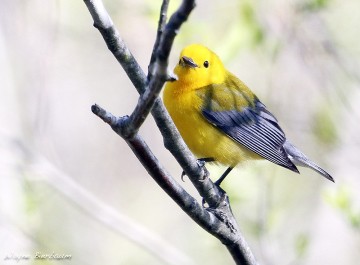This Week’s Creature Feature: The Yellow Birds of Spring
The spring bird migration has started. Soon flocks of warblers will be looking for the emerging bugs. Because it is spring, their feathers will show breeding hues. The hue that seems the most startling and catches my attention is bright yellow.
Two warblers are brilliant yellow, and both push through in high numbers to get to northern breeding grounds. But a few of both species will stay in Maryland to nest and rear the next generation. There is also a drab-colored winter seed-eater that turns bright yellow in the spring. These three birds are the yellow warbler, prothonotary warbler and American goldfinch.
The male yellow warbler is bright yellow with dark eyes and a dark thin pointed bill. Slightly dark orange stripes mark its chest. The females are much duller in color with an added green-brown tint. Yellow warbler are very common along the edge of forests and lakes. One of the most vocal birds, yellow warblers have lilting songs that are easily recognizable. Their unusual trait is making nests out of spider webbing. The nest stretches to accommodate the growing young.

The protonotary warbler, named after the golden robes of 17th-century prothonotaries or papal clerks, is bright golden yellow with grey wings. Unusual for birds, the female is almost as bright yellow as the male. They prefer living along rivers and swamps and nest in low tree cavities. Their song is high-pitched and infrequent. They pop in and out of cover and are seen more than heard.
The American goldfinch, a seed-eater, is a dull green-brown during the winter. But come April, both males and females make a yellow transformation, but the male is much brighter and has a black cap between his eyes.
Finches generally travel in small groups of flocks and chatter with each other while they fly. They will get along well until spring comes and they start to sing and chatter more. Then males try to show dominance by giving chase and joining aerial battles. They will eventually settle down and nest high in trees with several families sometimes in the same tree. Maryland goldfinches do not migrate, but when they get dull-brown in the winter they seem to disappear.
Yellow warblers like willow bushes. Prothonotary warblers like swamps and will take to nesting boxes. Goldfinches like flowers that go to seed, like black-eyed Susans.
